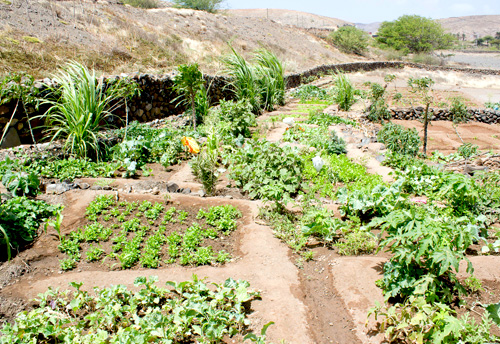I regularly count myself as fortunate ‘freelancer’, in the gardening world. I was recently a guest lecturer on a Fred. Olsen Cruise down to the Cape Verde Islands, an archipelago off the coast of Senegal, (No I didn’t know where they were, either!) once a Portuguese colony and tipped as the next ‘big’ holiday destination.
Despite the name, the two Islands we visited were not particularly ‘Verde’ – St Vincent was more like an arid Lanzarote and rainfall on the island is minimal (their last rainfall was seven months ago, a brief storm in October), yet remarkably, there are still artesian wells scattered around the island. I joined a couple from the ship, Ian and Gerry Silver, for a taxi tour, first ensuring that our driver was willing to stop at any time to photograph flowers!

The first stop in the arid landscape was to photograph an oasis of palms and a windmill by the road. To my utter amazement, by the windmill, there was a deep well and an immaculate vegetable garden, watered by an intricate system of channels, with a seedbed, chillies, aubergines and a unexpected range of brassicas. By watering effectively, even in this inhospitable climate, someone was producing some excellent crops.
We may need to do the same this summer, as rainfall levels are alarmingly low for the time of year, in most parts of the country. You may not have an artesian well but you can collect water in ‘butt’s’ from house and garage roofs. The best time to water is early in the morning or evening to reduce the amount of moisture lost by evaporation. Water thoroughly, applying it around the roots, don’t waste water using a sprinkler which covers the leaves and usually the nearby path as well, installing ‘seep hose’ or a drip irrigation system on a timer, is particularly effective.
Where practical, it is worth using a watering can, it may take longer, but by carrying water to your containers or flower bed, you certainly take more care when using it. Concentrate on anything which is newly planted, from bedding plants to last winter’s trees and shrubs and give everything a good soaking, not just a light sprinkling which encourages roots to the surface, making them more vulnerable to drought. The old gardening saying ‘The answer lies in the soil’ holds true here, too. If there is plenty of well rotted organic matter in the soil, it acts like a sponge, maintaining a high level of ‘available moisture’ for your plants. An alternative on lighter soils is to grow plants that thrive in those conditions. Wider spacing in the vegetable garden is means that each plant has a larger area from which the roots can extract water from the soil, so they can grow larger without the need for watering. Keep your garden weed free, too, so they do not compete with your plants for water and mulch when the soil is moist after watering or rain, conserves water, too. Watering podded or fruiting crops like peas, French beans or aubergines during flowering and fruiting makes them more productive, rather than simply producing leaves. Being water-wise, is certainly an exciting challenge, it is down to you, so go for it! Happy Gardening!
Matt


